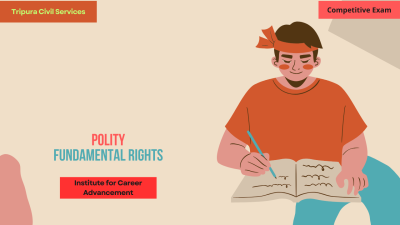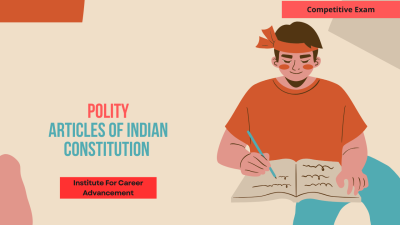Fundamental Rights
Fundamental Rights are a set of rights guaranteed to all citizens by the Constitution of India under Part III (Articles 12 to 35). These rights are essential for the personal freedom, dignity, and equality of individuals, forming the cornerstone of Indian democracy. They protect individuals from arbitrary actions by the state and ensure that the government operates within the framework of the rule of law. The key Fundamental Rights include: Right to Equality (Articles 14-18): Guarantees equality before the law and prohibits discrimination on the grounds of religion, race, caste, sex, or place of birth. Includes the abolition of untouchability and titles. Right to Freedom (Articles 19-22): Ensures freedoms of speech, expression, assembly, association, movement, residence, and profession. Also provides protection against unlawful arrest and detention. Right against Exploitation (Articles 23-24): Prohibits human trafficking, forced labor, and child labor (under 14 years of age). Aims to protect vulnerable sections of society from exploitation. Right to Freedom of Religion (Articles 25-28): Guarantees freedom to practice, propagate, and profess religion, subject to public order, health, and morality. Ensures religious equality and prohibits religious discrimination. Cultural and Educational Rights (Articles 29-30): Protects the rights of minorities to conserve their language, script, and culture. Ensures the right of minorities to establish and administer educational institutions. Right to Constitutional Remedies (Article 32): Empowers citizens to approach the Supreme Court or High Courts for the enforcement of their Fundamental Rights. Allows the courts to issue writs like Habeas Corpus, Mandamus, and Prohibition to protect these rights. These rights are justiciable, meaning they can be enforced by courts. However, they are subject to reasonable restrictions in the interest of national security, public order, morality, and the sovereignty of the nation. মৌলিক অধিকার হল তৃতীয় অংশের (12 থেকে 35 অনুচ্ছেদ) অধীনে ভারতের সংবিধান দ্বারা সকল নাগরিকের জন্য নিশ্চিত করা অধিকারের একটি সেট। এই অধিকারগুলি ব্যক্তিগত স্বাধীনতা, মর্যাদা এবং ব্যক্তির সমতার জন্য অপরিহার্য, যা ভারতীয় গণতন্ত্রের ভিত্তি গঠন করে। তারা রাষ্ট্রের স্বেচ্ছাচারী পদক্ষেপ থেকে ব্যক্তিদের রক্ষা করে এবং নিশ্চিত করে যে সরকার আইনের শাসনের কাঠামোর মধ্যে কাজ করে। মূল মৌলিক অধিকারগুলির মধ্যে রয়েছেঃ সমতার অধিকার (অনুচ্ছেদ 14-18) আইনের সামনে সমতার নিশ্চয়তা দেয় এবং ধর্ম, বর্ণ, বর্ণ, লিঙ্গ বা জন্মস্থানের ভিত্তিতে বৈষম্য নিষিদ্ধ করে। অস্পৃশ্যতা ও উপাধি বিলুপ্তির অন্তর্ভুক্ত রয়েছে। স্বাধীনতার অধিকার (ধারা 19-22) বাকস্বাধীনতা, মতপ্রকাশ, সমাবেশ, সমিতি, চলাচল, বাসস্থান এবং পেশার স্বাধীনতা নিশ্চিত করে। এছাড়াও বেআইনি গ্রেপ্তার এবং আটকের বিরুদ্ধে সুরক্ষা প্রদান করে। শোষণের বিরুদ্ধে অধিকার (অনুচ্ছেদ 23-24) মানব পাচার, জোরপূর্বক শ্রম এবং শিশু শ্রম নিষিদ্ধ (14 বছরের কম বয়সী) সমাজের দুর্বল অংশগুলিকে শোষণ থেকে রক্ষা করার লক্ষ্য। ধর্মের স্বাধীনতার অধিকার (অনুচ্ছেদ 25-28) জনশৃঙ্খলা, স্বাস্থ্য এবং নৈতিকতার সাপেক্ষে ধর্ম অনুশীলন, প্রচার এবং বিশ্বাসের স্বাধীনতার নিশ্চয়তা দেয়। ধর্মীয় সমতা নিশ্চিত করে এবং ধর্মীয় বৈষম্য নিষিদ্ধ করে। সাংস্কৃতিক ও শিক্ষাগত অধিকার (29-30 অনুচ্ছেদ) সংখ্যালঘুদের তাদের ভাষা, লিপি এবং সংস্কৃতি সংরক্ষণের অধিকার রক্ষা করে। শিক্ষা প্রতিষ্ঠান প্রতিষ্ঠা ও পরিচালনার ক্ষেত্রে সংখ্যালঘুদের অধিকার নিশ্চিত করা। সাংবিধানিক প্রতিকারের অধিকার (অনুচ্ছেদ 32) নাগরিকদের তাদের মৌলিক অধিকার প্রয়োগের জন্য সুপ্রিম কোর্ট বা হাইকোর্টের কাছে যাওয়ার ক্ষমতা প্রদান করে। এই অধিকারগুলি রক্ষার জন্য আদালতগুলিকে হেবিয়াস কর্পাস, ম্যান্ডামাস এবং নিষিদ্ধকরণের মতো রিট জারি করার অনুমতি দেয়। এই অধিকারগুলি ন্যায়সঙ্গত, যার অর্থ এগুলি আদালত দ্বারা প্রয়োগ করা যেতে পারে। তবে, জাতীয় নিরাপত্তা, জনশৃঙ্খলা, নৈতিকতা এবং জাতির সার্বভৌমত্বের স্বার্থে এগুলি যুক্তিসঙ্গত বিধিনিষেধের অধীন।
English
Last updated
Sat, 11-Jan-2025



















